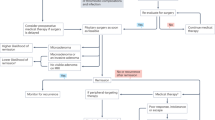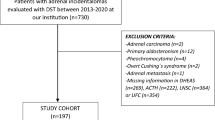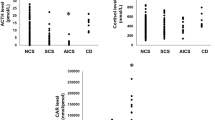Abstract
Steroid synthesis inhibitors are commonly used in the treatment of patients with Cushing's disease, but may also improve psychopathology in hypercortisolemic depressed patients. Since glucocorticoids exert a negative feedback at pituitary and supra-pituitary levels, the inhibition of steroid synthesis may lead to increased expression of corticotropin-releasing hormone (CRH) and arginine vasopressin (AVP). We studied the effect of treatment with 800 mg ketoconazole (3 weeks) upon the concentrations of basal plasma cortisol in the evening, corticosteroid-binding globulin (CBG), dehydroepiandrosterone-sulfate (DHEA-S), and ACTH as well as the concentrations of cortisol, CRH, and AVP in cerebrospinal fluid (CSF) at 8.30 h in 10 healthy, male volunteers. While we found cortisol plasma concentrations to be unchanged, we noted a significant increase in ACTH (post: 45.1±43.5; pre: 14.2±5.2 pmol/l; F1,8=9.78, p<0.02) and CBG concentrations (post: 38.8±4.3; pre: 31.9±4.2 μg/l), but DHEA-S plasma concentrations declined (post: 1.75±1.83; pre: 2.75±2.80 mg/l; F1,8=7.9, p<0.03). CRH concentrations in CSF were unchanged after treatment (post: 62.5±15.9; pre: 63.7±13.9 pg/ml), while there was a trend for AVP concentrations to rise during treatment (post: 2.52±1.18; pre: 1.92±0.96 pg/ml; paired t=−1.9, p<0.1). Cortisol CSF concentrations declined in the elderly (pre: 52.5±23.2; post: 26.7±4.6 nmol/l), but not in the young subgroup (pre: 15.6±11.3; post: 27.7±9.4 nmol/l). We thus conclude that the treatment of healthy controls with steroid-synthesis inhibitors does not lead to a major increase in CRH secretion.
Similar content being viewed by others
Log in or create a free account to read this content
Gain free access to this article, as well as selected content from this journal and more on nature.com
or
References
Arborelius L, Owens MJ, Plotsky PM, Nemeroff CB (1999). The role of corticotropin-releasing factor in depression and anxiety disorders. J Endocrinol 160: 1–12.
Deuschle M, Gotthardt U, Schweiger U, Weber B, Körner A, Schmider J, et al (1997a). With aging in humans the activity of the hypothalamus–pituitary–adrenal system increases and its diurnal amplitude flattens. Life Sci 61: 2239–2246.
Deuschle M, Schweiger U, Weber B, Gotthardt U, Körner A, Schmider J, et al (1997b). Diurnal activity and pulsatility of the hypothalamus–pituitary–adrenal system in male depressed patients and healthy controls. J Clin Endocrinol Metab 82: 234–238.
Ebner K, Wotjak CT, Holsboer F, Landgraf R, Engelmann M (1999). Vasopressin released within the septal brain area during swim stress modulates the behavioural stress response in rats. Eur J Neurosci 11: 997–1002.
Heuser I, Bissette G, Dettling M, Schweiger U, Gotthardt U, Schmider J, et al (1998). Cerebrospinal fluid concentrations of corticotropin-releasing hormone, vasopressin and somatostatin in depressed patients and healthy controls: response to amitriptyline treatment. Depress Anxiety 8: 71–79.
Heuser I, Schweiger U, Gotthardt U, Schmider J, Lammers C, Dettling M, et al (1996). Pituitary–adrenal-system regulation and psychopathology during amitriptyline treatment in elderly depressed patients and normal comparison subjects. Am J Psychiatry 153: 93–99.
Holsboer F (1999). The rationale for corticotropin-releasing hormone receptor (CRH-R) antagonists to treat depression and anxiety. J Psychiatr Res 33: 181–214.
Holsboer F (2000). The corticosteroid receptor hypothesis of depression. Neuropsychopharmacol 23: 477–501.
Ixart G, Siaud P, Mekaouche M, Barbanel G, Givalois L, Assenmacher I (1994). Short-term but not long-term adrenalectomy modulates amplitude and frequency of the CRH41 episodic release in push–pull cannulated median eminence of free-moving rats. Brain Res 658: 185–191.
Jenkins JS, Mather HM, Ang V (1980). Vasopressin in human cerebrospinal fluid. J Clin Endocrinol Metab 50: 364–367.
Kovacs KJ, Foldes A, Sawchenko PE (2000). Glucocorticoid negative feedback selectively targets vasopressin transcription in parvocellular neurosecretory neurons. J Neurosci 20: 3843–3852.
Landgraf R, Neumann I, Holsboer F, Pittman QJ (1995). Interleukin-1ß stimulates both central and peripheral release of vasopressin and oxytocin in the rat. Eur J Neurosci 7: 592–598.
Loli P, Berselli ME, Tagliaferri M (1986). Use of ketoconazole in the treatment of Cushing's syndrome. J Clin Endocrinol Metab 63: 1365–1371.
Ma XM, Aguilera G (1999). Differential regulation of corticotropin-releasing hormone and vasopressin transcription by glucocorticoids. Endocrinology 140: 5642–5650.
Raadsheer FC, Hoogendijk WJ, Stam FC, Tilders FJ, Swaab DF (1994). Increased numbers of corticotropin-releasing hormone expressing neurons in the hypothalamic paraventricular nucleus of depressed patients. Neuroendocrinology 60: 436–444.
Schmidt ED, Janszen AW, Binnekade R, Tilders FJ (1997). Transient suppression of resting corticosterone levels induces sustained increase of AVP stores in hypothalamic CRH neurons of rats. J Neuroendocrinol 9: 69–77.
Schulkin J, Gold PW, McEwen BS (1998). Induction of corticotropin-releasing hormone gene expression by glucocorticoids: implication for understanding the states of fear and anxiety and allostatic load. Psychoneuroendocrinol 23: 219–243.
Scott LV, Dinan TG (1998). Vasopressin and the regulation of hypothalamic–pituitary–adrenal axis function: implications for the pahtophysiology of depression. Life Sci 62: 1985–1998.
Stalla GK, Stalla J, Schopohl J, von Werder K, Müller OA (1986). Corticotropin-releasing factor in humans. Hormone Res 24: 229–245.
Stalla GK, Stalla J, von Werder K, Müller OA, Gerzer R, Holt V, et al (1989). Nitroimidazole derivates inhibit anterior pituitary cell function appraently by a direct effect on the catalytic subunit of the adenylate cyclase. Endocrinology 125: 699–706.
Tomori N, Suda T, Tozawa F, Demura H, Shizume K, Mouri T (1983). Immunoreactive corticotropin-releasing factor concentrations in cerebropsinal fluid from patients with hypothalamic–pituitary–adrenal disorders. J Clin Endocrinol Metab 57: 1305–1307.
Wolkowitz OM, Reus VI (1999). Treatment of depression with antiglucocorticoid drugs. Psychosom Med 61: 698–711.
Wolkowitz OM, Reus VI, Chan T, et al (1999a). Antiglucocorticoid treatment of depression: double-blind ketoconazole. Biol Psychiatry 45: 1070–1074.
Wolkowitz OM, Reus VI, Keebler A, Nelson N, Friedland M, Brizendine L, et al (1999b). Double-blind treatment of major depression with dehydroepiandrosterone. Am J Psychiatry 156: 646–649.
Zobel AW, Nickel T, Kunzel HE, Ackl N, Sonntag F, Ising M, et al (2000). Effects of the high-affinity corticotropin-releasing hormone receptor 1 antagonist R121919 in major depression: the first 20 patients treated. J Psychiatr Res 34: 171–181.
Acknowledgements
We thank Ms Heuer for expert technical assistance and Ms VanSyckel for assisting in the preparation of the manuscript. None of the authors has any conflict of interest with this paper.
Author information
Authors and Affiliations
Corresponding author
Additional information
This study was supported by a grant of the Deutsche Forschungsgemeinschaft to MD and IH (DFG De 660/4-1).
Rights and permissions
About this article
Cite this article
Deuschle, M., Lecei, O., Stalla, G. et al. Steroid Synthesis Inhibition with Ketoconazole and its Effect upon the Regulation of the Hypothalamus–Pituitary–Adrenal System in Healthy Humans. Neuropsychopharmacol 28, 379–383 (2003). https://doi.org/10.1038/sj.npp.1300044
Received:
Revised:
Accepted:
Published:
Issue date:
DOI: https://doi.org/10.1038/sj.npp.1300044
Keywords
This article is cited by
-
A review of the serotonin transporter and prenatal cortisol in the development of autism spectrum disorders
Molecular Autism (2013)
-
Farmaci interferenti sulla steroidogenesi cortico-surrenalica
L'Endocrinologo (2008)
-
Combined treatment with ketoconazole and cyproterone acetate in a boy with McCune-Albright syndrome and peripheral precocious puberty
Journal of Endocrinological Investigation (2008)
-
Escalated aggression as a reward: corticosterone and GABAA receptor positive modulators in mice
Psychopharmacology (2005)



